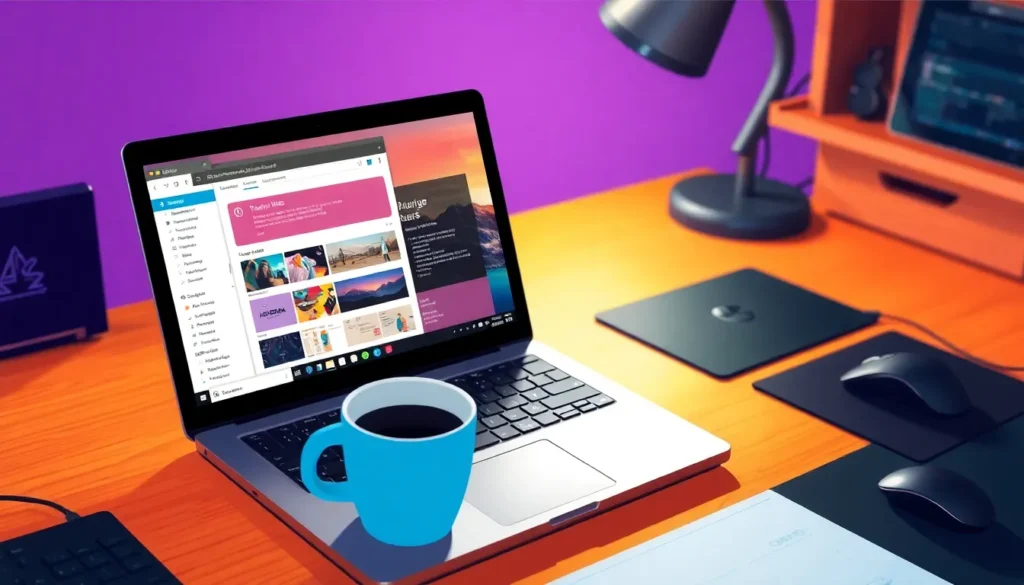Table of Contents
ToggleWindows Terminal is like the Swiss Army knife of command line tools—packed with features that can transform a mundane task into a productivity powerhouse. Whether you’re a seasoned developer or just someone who’s tired of clicking around, mastering this tool can save time and sanity. It’s not just about typing commands; it’s about unleashing your inner tech wizard and making your workflow smoother than a buttered slide.
Understanding Windows Terminal
Windows Terminal serves as a modern command-line interface that supports multiple tabs, shells, and customizable user experiences. This tool enhances productivity, making routine interactions with the system efficient and streamlined.
Features Overview
Windows Terminal features multiple tabs, allowing users to run various shell sessions simultaneously. Users benefit from support for Windows PowerShell, Command Prompt, and Windows Subsystem for Linux (WSL). Tabs can be rearranged to suit preferences, significantly improving workflow management. A GPU-accelerated text renderer enhances display speed and efficiency. Moreover, it supports Unicode and UTF-8 characters, enabling diverse language usage. Users gain access to a customizable interface with themes and backgrounds, making it visually appealing.
Customization Options
Windows Terminal offers extensive customization options, allowing users to tailor their experience. Users can adjust settings through a JSON file or graphical user interface. Themes, fonts, and colors can be customized to match individual preferences. Keyboard shortcuts can be modified to streamline command access. Additionally, users can create custom profiles for different shell environments, enhancing organization. Background images and acrylic effects provide a polished look, achieving a professional appearance while improving readability. All these options contribute to a user-friendly and aesthetically pleasing command-line tool.
Productivity Tips

Boosting productivity with Windows Terminal involves leveraging its features effectively. Users can significantly enhance their efficiency by mastering a few essential tools and shortcuts.
Keyboard Shortcuts
Utilizing keyboard shortcuts saves time and minimizes repetitive tasks. Each shortcut streamlines interactions; for instance, Ctrl + Shift + T opens a new tab, while Ctrl + W closes the current tab. Familiarity with Alt + Arrow Keys navigates between tabs effortlessly. Custom shortcuts, available through key bindings, enable tailored experiences that align with individual workflows. Learning these shortcuts fosters a quicker, more efficient command line experience.
Profile Management
Managing profiles enhances the versatility of Windows Terminal. Users can create distinct profiles for different tasks, such as development or system administration. Each profile permits specific configurations, including shell selection and visual themes. Custom profiles streamline access and create a personalized environment. Importing and exporting profiles allows for easy sharing across systems, reinforcing consistency and efficiency. Organizing these profiles saves time and supports clearer task management.
Terminal Tricks
These tricks enhance productivity and streamline the command line experience in Windows Terminal.
Using Multiple Tabs
Utilizing multiple tabs increases efficiency. Open new tabs with Ctrl + Shift + T, allowing users to run distinct sessions simultaneously. Customizing each tab with unique profiles promotes organization. Switching between tabs occurs easily with shortcuts like Ctrl + Tab. To close a tab, use Ctrl + W. Managing multiple tasks within this setup simplifies workflows, enabling quick access to various shell environments.
Splitting Panes
Splitting panes maximizes screen real estate. Users achieve this by using the shortcut Alt + Shift + D, creating vertical or horizontal layouts. Each pane can run a different shell session, making multitasking seamless. Navigating between panes is straightforward with the arrow keys. Adjusting pane sizes quickly allows users to focus on specific tasks or outputs. This feature enhances simultaneous task execution, ensuring efficient use of the terminal workspace.
Advanced Techniques
Advanced techniques in Windows Terminal can significantly enhance user experience and efficiency. Users can utilize custom command line tools to streamline common tasks. Creating alias commands speeds up repetitive commands, allowing for instant access with less typing. For example, one could set an alias for frequently used scripts, making those scripts accessible with a simple keyword.
Integration with other applications further maximizes productivity. Windows Terminal supports integration with popular tools like Visual Studio Code and Git. Synergy between the Terminal and these applications enables seamless workflows. Users can open projects directly within the Terminal, facilitating transitions between coding and command input. Additionally, automating workflows through scripts enhances efficiency, allowing users to execute complex tasks with minimal effort. This collaboration between tools fosters a cohesive and efficient environment, streamlining developer processes.
Embracing Windows Terminal can transform the way users interact with their systems. By leveraging its powerful features and customization options, individuals can significantly boost their productivity.
Mastering keyboard shortcuts and utilizing profiles ensures a smoother workflow while multitasking becomes effortless with tabs and split panes.
As users explore advanced techniques and integrations, they’ll find that Windows Terminal not only enhances efficiency but also creates a more enjoyable command line experience. With these tips and tricks, anyone can unlock the full potential of this versatile tool.







